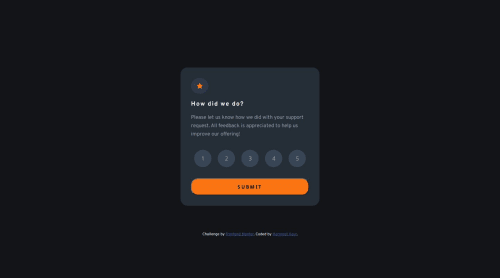Frontend Mentor | Interactive rating component

Solution retrospective
I am struggling with selecting only one button at a time, it is letting me select multiple buttons and not deselecting the other. Please advise on this. Or any other feedback will also do. Thanks!
Please log in to post a comment
Log in with GitHubCommunity feedback
- P@huyphan2210
Hi, @hkaur108
I've reviewed your solution and noticed your questions. Here are some thoughts:
1. Using jQuery for DOM Manipulation:
To ensure only the selected button has the
.activeclass, you need to remove the.activeclass from all buttons with the.btnclass before applying it to the clicked button. Here’s an example:$('.btn').on('click', function(e) { // Remove unnecessary console.log if not debugging // console.log(e); // Remove the .active class from all .btn elements $('.btn').removeClass('active'); // Add the .active class to the clicked .btn $(this).addClass('active'); // Avoid inline styling. Define the background color in your CSS instead });2. Avoid Inline Styles:
Inline styles like
$(this).css("background-color", "white");are best avoided. Instead, define thebackground-colorin your CSS or SCSS for the.activeclass. This keeps your styles separate from the script, making your code cleaner and easier to maintain.3. CSS Specificity Issue:
I noticed you’ve defined an
.activeclass in your SCSS file, but itsbackground-coloris being overwritten. This is likely due to specificity. In CSS, the rule with higher specificity takes precedence.For example, if your
.btnclass is inside a.button-container, your.activeclass might not apply correctly because it’s not specific enough. Update your SCSS to:.button-container .btn.active { background-color: white; // Or your desired color }Why?
.button-container .btn.active is more specific than.active.- It ensures the
background-colorfor.activeis applied, even if other classes like.button-container .btnhave conflicting rules.
Hope this helps!
Marked as helpful - @hannibal1631
Well first of all let me know where is it not letting you select one button at a time. CSS or JS?
Join our Discord community
Join thousands of Frontend Mentor community members taking the challenges, sharing resources, helping each other, and chatting about all things front-end!
Join our Discord